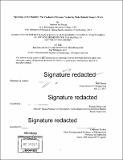| dc.contributor.advisor | Wanda Orlikowski. | en_US |
| dc.contributor.author | Beane, Matthew I. (Matthew Ian) | en_US |
| dc.contributor.other | Sloan School of Management. | en_US |
| dc.date.accessioned | 2018-03-02T22:20:30Z | |
| dc.date.available | 2018-03-02T22:20:30Z | |
| dc.date.copyright | 2017 | en_US |
| dc.date.issued | 2017 | en_US |
| dc.identifier.uri | http://hdl.handle.net/1721.1/113956 | |
| dc.description | Thesis: Ph. D., Massachusetts Institute of Technology, Sloan School of Management, 2017. | en_US |
| dc.description | Cataloged from PDF version of thesis. | en_US |
| dc.description | Includes bibliographical references (pages 137-149). | en_US |
| dc.description.abstract | Though a 2.5-year mixed-method study comparing robotic surgical practice to traditional surgical practice, I explore how crucial outcomes require productive deviance: norm- and policy-challenging practices that are tolerated because they produce superior outcomes in the work processes governed by those norms and policies. My empirical focus was fortunate - I show that productive deviance is likely especially important in the first ten to twenty years of significant technical reconfiguration of surgical work. I open my dissertation through a comparative empirical introduction to my context and a review of the literature on deviance in organizations. The second chapter of my thesis is a history of how the surgical profession has relied on productive deviance for integrating new technologies since the early 1800s, ending with a deeper treatment on robotic surgery. My third chapter focuses on how only a very few surgical residents managed to gain confidence and competence with robotic surgical methods given significant barriers to such learning. In contrast to what the standing literature on learning would predict and in tension with the norms for learning within the surgical profession, these residents engaged in a suite of practices I call "shadow learning" - involving premature specialization, abstract rehearsal and undersupervised struggle. I explore how each of these practices both allow progress and create unintended negative consequences for the profession. My fourth chapter explores a case in which surgical teams routinely used new, well-maintained robotic surgical devices and occasionally faced the stressful and practically difficult task of using an under-maintained, unreliable surgical robot. In this chapter, I show quantitatively that patients did just as well on the degraded robot, and I outline the often invisible, undervalued "compensatory work" that professionals did to ensure such outcomes. The main contribution here is to explicitly treat affect as integral to coordinated work that is grounded in suboptimal material arrangements. Through these studies, I solidify and enrich our conception of productive deviance and show how it is critical for a range of professional and organizational outcomes. | en_US |
| dc.description.statementofresponsibility | by Matthew Ian Beane. | en_US |
| dc.format.extent | 159 pages | en_US |
| dc.language.iso | eng | en_US |
| dc.publisher | Massachusetts Institute of Technology | en_US |
| dc.rights | MIT theses are protected by copyright. They may be viewed, downloaded, or printed from this source but further reproduction or distribution in any format is prohibited without written permission. | en_US |
| dc.rights.uri | http://dspace.mit.edu/handle/1721.1/7582 | en_US |
| dc.subject | Sloan School of Management. | en_US |
| dc.title | Operating in the shadows : the productive deviance needed to make robotic surgery work | en_US |
| dc.title.alternative | Productive deviance needed to make robotic surgery work | en_US |
| dc.type | Thesis | en_US |
| dc.description.degree | Ph. D. | en_US |
| dc.contributor.department | Sloan School of Management | |
| dc.identifier.oclc | 1023435140 | en_US |
